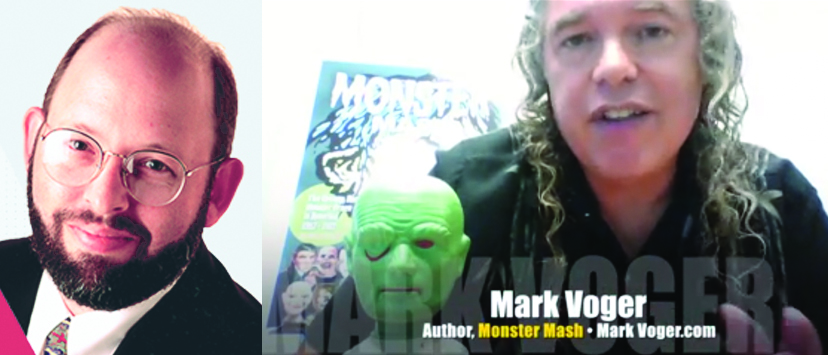
Al Lewis’ ears were burning
By Mark Voger, author, “Monster Mash: The Creepy, Kooky Monster Craze in America 1957-1972″
I was fortunate enough to be a guest on “Mr. Media,” the video-podcast interview show hosted by Bob Andelman. My segment was recorded on Aug. 18, 2015, a Tuesday, and was posted the following Friday. I gave the interview on a hastily borrowed laptop in a commandeered conference room at NJ Advance Media in Edison, where I work producing The Star-Ledger, the Times of Trenton and other publications. Following is a transcript of our conversation.
Andelman: Today on “Mr. Media,” I’ll talk to Mark Voger, the author of “Monster Mash: The Creepy, Kooky Monster Craze in America 1957-1972.” It is a wow of an illustrated piece of pop American culture, with a flowing narrative that fills in a lot of details and trivia. Stick around. This is bound to be a graveyard smash.
(“Mr. Media” I.D.s and music are played.)
Click below to watch interview.
Andelman: “Mr. Media” is recorded live before a studio audience full of werewolves, zombies, vampires and other assorted neighbors of mine, in the new new-media capital of the world, St. Petersburg, Florida.
1957. That must have been a helluva year to have been alive. I mean, I wouldn’t know; my birth was still a few years off. But coming on the heels of the comic book industry nearly being wiped out by Fredric Wertham’s book “Seduction of the Innocent,” and the subsequent (Estes) Kefauver hearings of the U.S. Senate, a few in the media still dared to challenge the country to consume something more than pablum in 1957: monsters.
After lying low for several Communist-witch-hunt years, movie monsters made a big comeback in 1957. “I Was a Teenage Werewolf” with Michael Landon was first, followed by “Curse of Frankenstein” the very next week. Not even TV was safe, as Screen Gems rolled out its “Shock!” package of 52 Universal horror films to independent and hard-to-find UHF stations. And if you don’t know what a UHF station is, go ask your parents. As Mark Voger writes in his new book, “Monster Mash: The Creepy, Kooky Monster Craze in America 1957-1972,” “1957 was the nail in the coffin for genre naysayers. Taboos were being broken. The stake had been removed.”

This is a sensational book for its illustrated trip down Memory Lane aimed at the generations of us watching late-night movie hosts such as Zacherley; listening to Bobby Pickett sing “Monster Mash”; building and painting Frankenstein monster scale models; convincing Mom to let us watch “The Munsters”; collecting and trading Topps’ “Ugly Stickers” — and boy, were they ugly. And reading Famous Monsters of Filmland magazine, or my personal favorite, The Monster Times.
This summer has even echoed those long-gone days. Have you heard Fallout Boys’ hit single “Uma Thurman”? Over and over, it repeats the guitar riff from the “Munsters” theme song. And with that, Mark Voger, welcome to “Mr. Media.”
Voger: Thank you, Bob. It’s great to be here. And from your lips to God’s ears.
Andelman: (Laughs) I think that’s how it works. Or, as they would say on “The Office,” “That’s what she said.” Now, I knew that I would love this book when I first heard about it, Mark, and getting it my hands was no disappointment. But how did you decide to pursue this particular topic?
Voger: Well, Bob, it’s a labor of love. I think it’s the book I was meant to do. It’s my third, but it’s really me. Working on the whole project – I really researched it all my life. The first interview I did for it was in the late ’80s. When I started the book “proper,” it was 14 months. But it really did feel like a lifetime. I honestly feel that my inner 8-year-old is the guy who wrote this book.
Andelman: He would have if he could have, right?
Voger: Yeah. I made sure that he would be happy. (Lifting toy) I brought this as a little bit of comfort. It’s a Frankenstein Soaky from 1963, a bubble bath toy.
Andelman: Wow.
Voger: My mom wouldn’t buy it for me in ’63, so I bought it for only 45 dollars about 15 years ago.
Andelman: And who’s your other friend?
Voger: I brought the Wolf Man and I brought the Mummy (Soaky toys) also. You probably know, Bob, I only need one more: the Creature. But he’s very expensive. He’s, like, a buck and a quarter ($125). It might be a few years before I get my Creature.

Andelman: Oh, come on. You’ve got a high-paying newspaper job, don’t you?
Voger: I have a high-paying newspaper job, and also, I have job security. I’m set. I’m set.
Andelman: Yeah. In the newspaper industry. I did my part. I subscribed to that newspaper in the ’70s, so I’ve done all I can do for you.
Voger: Bob is talking about The Star-Ledger. I slap together pages for The Star-Ledger, and once in a while, I write for The Star-Ledger, still.
Andelman: There you go. And I should point out that we’re both born-and-bred Jersey boys …
Voger: Represent.
Andelman: … yes. And I think that’s part of why this meant a lot to me, to read and talk to you, was that I think we have that commonality, the experiences and the things that we were exposed to. And probably the things that our parents wouldn’t buy us when we were young kids.
Voger: It’s weird, because I have a lot of friends — like, actual dear friends — who were into this stuff back then, and they still are now. One is a film critic; one is an art director for newspapers; one is a novelist; one is an actor, a very accomplished actor. And I just heard from a gentleman named Greg Nicotero, who is a director and zombie designer on “The Walking Dead.” He’s a little younger than you, I think, Bob, and he loved this stuff. You’re in the media; you’re Mr. Media. It almost seems that a lot of the guys that loved this stuff back then somehow eked out careers for themselves. It’s strange.
Andelman: It’s a lot of work just to get to be able to afford some of these toys.
Voger: Oh, yeah. The Mummy — I don’t even want to tell you what I paid for the Mummy. I just look at it as an investment. I could probably turn it around on eBay and get another 15 dollars for it just like that.
Andelman: Oh, just like that, huh? So tell us a little more about your personal connection to the material. You were too young in the ’50s yet, but in the ’60s, what was the stuff that you remembered that caught your eye and stayed with you?
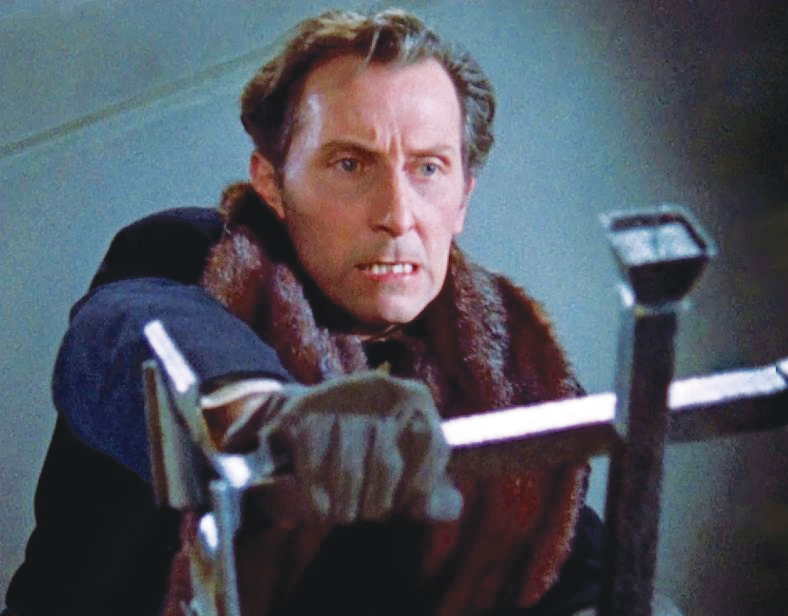
Voger: It probably was the Frankenstein Soaky first. I was born in ’58, so by the time I was starting to become aware of the world around me, monsters were already there. They were confusing to me. I didn’t understand that reaction of simultaneous attraction and repulsion. Because you’d see a monster face, and it would scare you — some of those FM (Famous Monsters magazine) covers are still frightening, I think — but at the same time, it was like a rush, and you wanted more.
And then, I’m a Catholic school boy. That really confused me even further. Because the nuns and the priests were always beating it into us — literally, beating it with rulers — saying, “We’re the one, true church. Everybody else is wrong. We’re right.” Then I would see a Dracula movie, and Peter Cushing would whip out a crucifix. Then they’d have a close-up of it. They’d play church music. They’d have a light on it. Dracula would recoil in horror. And I just thought, as a 6-year-old, “Oh, I guess the nuns are right. I guess we’re the one, true church.” Because you can’t stop Dracula with a gun, but you whip out a crucifix, he’s toast.
Andelman: When was the point when you realized there was a connection — I’m guessing this was as an adult — between what went on in the ’50s, Fredric Wertham and (Estes) Kefauver and the comic book companies all pulling back and the movie studios pulling back, that connection to the Communist witch hunt, all that kind of stuff. When do you make that connection?
Voger: Well, much like yourself, Bob, I did become a comic book fanatic. A fan. Even as a young adult, I hadn’t learned everybody’s names. I wasn’t, like, so savvy. I rediscovered them as an adult. And then all of a sudden I’m, like, “Wow.” Jack Kirby and Kurt Schaffenberger. Ross Andru is a big favorite of mine. Curt Swan, Steve Ditko. You easily not only identify their styles, but you can also kind of tell what decade they drew it in, if you’re a real aficionado. And then, just research. I found out about the witch hunt. You mentioned Kefauver. I recently watched a Bettie Page documentary, and he tried to stop her, too. So it’s just like: Wow, this guy who almost became vice president tried to stop Bettie Page and horror comics and EC Comics. So — what a guy.
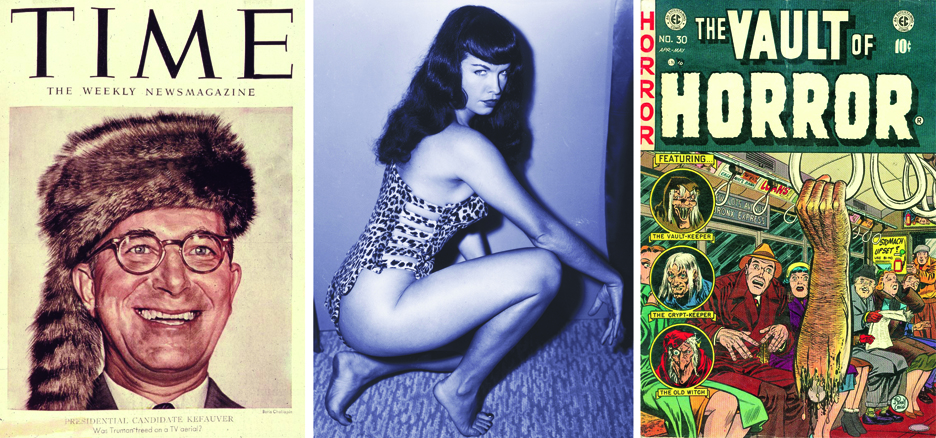
Andelman: And he was a Democrat, as I recall.
Voger: Yeah. Well, such was the social paranoia that was going on in the 1950s. There was just so much of: “You’re either one of us, or you’re one of them.” I think that rock ’n’ roll and the Monster Craze were two things that were these organic things, these kind of accidental revolutions that happened. You know, an 8-year-old kid isn’t worried about politics, isn’t worried about being seen as an “other.” He just sees Frankenstein and says, “Wow, that’s cool.”
Andelman: Well, it was a time, too, of young people challenging all of the conventions of the establishment. We had words we couldn’t spell, like “anti … dis … establish …” (trails off) well, anyway …
Voger: I just say “super-cali-fragilistic” on that one.
Andelman: There you go. That’s the word. But it turns out that the monsters weren’t Frankenstein. The monsters were real people. They were the ones who caused people who believed in freedom and democracy to be afraid at night. Those were the real monsters of that era, weren’t they?
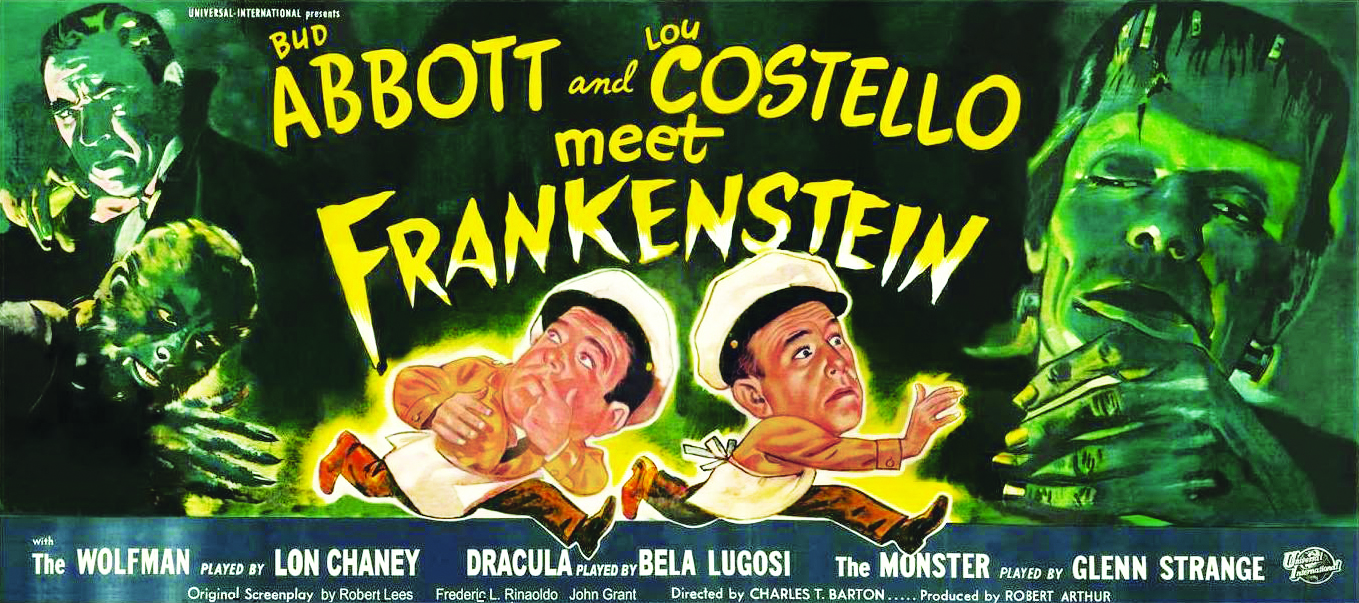
Voger: Absolutely. And then, even going back. I own a book called “No Traveler Returns” (by Gary D. Rhodes and Bill Kaffenberger). It’s about Bela Lugosi’s lost years. And I hadn’t known this, but they make a great case that conventional monsters like Frankenstein — who was last seen in 1948 in “Abbott and Costello Meet Frankenstein,” and then not seen again for many years — they were kind of marginalized. Because the Nazi atrocities were in the newsreels. So people were seeing them, pre-television. They were seeing them on the big screen, before their movies. That was one of the things that — how could monsters be scary anymore when the monsters of real life are so much more terrible?
Andelman: I hadn’t thought about that. That makes a great point. That takes it back another generation. So let’s get into the meat of the book. The art in this book is spectacular. Every time I turned the page, I was like, “Wow, this is cool. I remember this. I remember this.” But what I wondered is, did you struggle to find the art, or was there so much art, you were forced to choose between what to keep in and what to keep out?
Voger: Well, Bob, a little of both. A lot of the photos, 80 photos in the book, were taken by my late wife, Kathy Voglesong. We were a writer/photographer team. Our first assignment was our honeymoon. We did a travel story out of it. And so we always covered the convention scene. We’d go to Fango conventions, comic book conventions, anything. We would always go early and just cruise the vendors. And I’d say, “Oh, cool, a Wolf Man Soaky! Can we take a picture of it?” So a lot of those photos of the memorablilia, we’d been shooting them for 20 years.
But right up to the end, there were things I wanted that I couldn’t get. I’ll just show you one example. I have it here (holds up “Monster Mash” book). There was an Uncle Fester puppet from 1964. Here he is, right here (opens book to page showing puppet). This is my favorite page in the book.
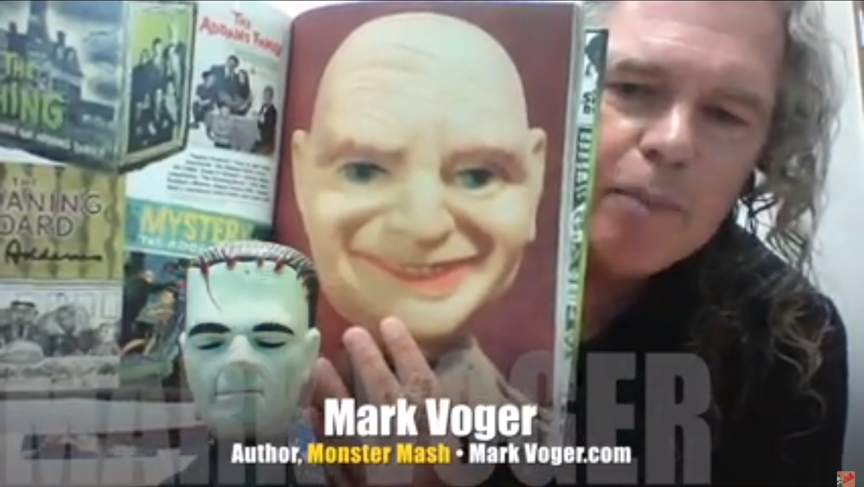
Andelman: Really.
Voger: Yeah. Because it’s one full page of just, like, an extreme close-up of the Uncle Fester puppet.
Voger: So ugly, too.
Andelman: Yeah. What happened was, towards the end, I suddenly remembered, “Oh! Mark Lovecchio in fourth grade had this great Uncle Fester puppet! I’ve gotta get it in the book.” And that one, I’ll tell you, I paid 85 bucks for. But I wanted him in the book. So it was like a combination. There are a couple of toys that I was, “Ooh, I didn’t get it in.” But for the most part, I’m pleased. I think I touched on everything.
Andelman: Did you track down Mark to get it (the Fester puppet), or did you find it some other way?
Voger: No, I got it through eBay. It was even better than I remembered. Because I just remember it being cool. But then when I looked at it as an adult — his facial expression is really hard to describe. It’s almost like he’s pleased with something very horrible that just happened.
Andelman: It’s interesting. I remember there’s that one very famous Frankenstein scale model. … I remember my next-door neighbor having it. He and I didn’t have a whole lot in common. He had an older brother, which I did not. I don’t know if he or his older brother made and painted that model. But, boy, I wanted that for years. It’s something my parents would never buy me.
But we also traded — this was the other thing I loved in the book — the “Ugly Stickers.” Again, these things come down to you and your friends in the ’60s. … We bought, sold and traded those things. To me, seeing so many of those reprinted in the book was the key thing I loved about this book. Just capturing that moment in time for me.
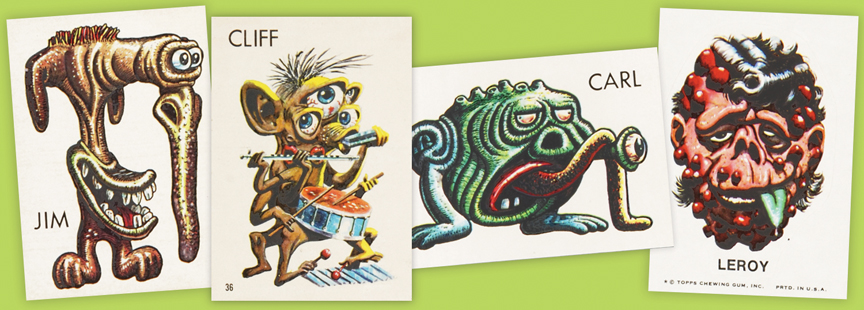
Voger: Thank you, Bob. One of the things that a lot of us adults looking back on this stuff — we always kind of refer to it as “porn.” When we got an issue of Famous Monsters of Filmland, the first thing we did was just, page by page, go through it. And we’d be, “Aw, look at that! Look at that!” And then later in life, we were like, “That was porn for us.” Same thing with the “Ugly Stickers.” When you opened a pack of those things, the first thing you did was just — there were probably five in the pack — you just looked at them. That’s the same effect I’m trying to get, is: Bring that back. I designed the book, also, so I had complete control over that flow and that look.
Andelman: And, of course, we graduated to Vampirella.
Voger: Vampirella was much more fun to look at than Uncle Creepy and Cousin Eerie.
Andelman: Yeah, once you realized that you were interested in — we didn’t call it “porn” at the time. We were too young. But once you realized that you were more interested in those images than — still, I would take a pack of those “Ugly Stickers” any day, now. I still find myself — you know, the old shops where you would get Topps baseball cards or the “Ugly Stickers” — there’s certain smells that will take you back immediately. I think: “Gee, I wonder if they have those …” No, it’s been 30, 40 years. They don’t have “Ugly Stickers” anymore. They’re gone.
Voger: It’s funny you mentioned Vampirella. When she debuted in ’69, I was 11. So I was, like, perfect. It was like: Thank you, God, for Vampirella.
Andelman: Tell me about some more of your favorite things that you found in the book, or people that you talked to.
Voger: Well, that, again, was something that — I was always working on it. And I remember thinking things like, “I’ve gotta get Bobby (Boris) Pickett on the phone,” and “I’ve gotta get James Bama,” who painted all of the Aurora box art. “I’ve gotta get him on the phone. He’s still alive.” He’s still alive, but Bobby (Boris) Pickett left us. So I would just go after everybody.
I wrote about — I hate to use the word “wrote,” past tense. But I’ll say I write about pop culture. For all those years. I was at the Asbury Park Press for 26 years and then at The Star-Ledger for six years, before we just did a reorganization. So I would always go after somebody from “The Brady Bunch” or “The Partridge Family” or somebody in Ten Years After or the Beatles. Anything retro pop culture, I just went after them. So I have a lot of interviews.
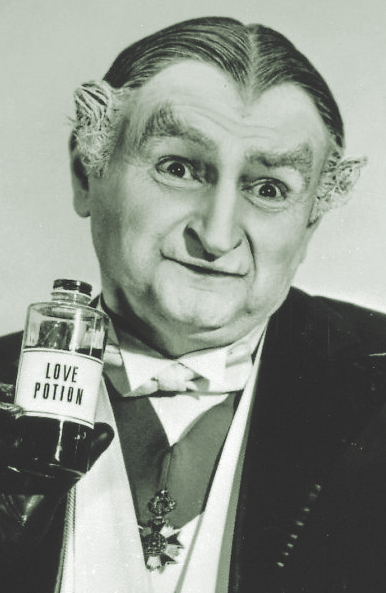
In the book, I always tell you what year — if it’s a Pat Priest interview — what year it was done. The interviews are timeless; we’re only talking about stuff that happened in 1964 or whatever. But I just wanted you to kind of know (what year the interview was conducted). But, yeah, that’s what I did. The people that I talked to were just all wonderful. Grandpa Munster was awesome, because …
Andelman: Al Lewis.
Voger: Al Lewis. Because the weird thing about him …
Andelman: Everything’s weird about him. Let’s not isolate — everything about Al was weird.
Voger: The not weird thing about Al Lewis — but I knew that he was at his restaurant, Grandpa’s Bella Gente, in the Village in New York City. So I went there one day, and he sat down at our table, gave us an interview, posed for pictures, smoked these smelly stogies, and his nails were really long. That was another weird thing. But the weird thing about talking with him was, it was really like talking to Grandpa Munster. There was no difference. He would berate you. He would say, “Good gracious me.” So Al and Grandpa were, I think, one and the same, except for Al didn’t sleep in a coffin.
Andelman: You’d think.
Voger: Until …
Andelman: And he became part of, on and off, over the years, the Howard Stern show, of all things. He popped up there. He became, on his own, as Grandpa Munster, in New York, at the restaurant, right? He had this whole life that went on beyond the TV show.
Voger: He ran for mayor of New York City, and he was serious about it. He was a character. A one-of-a-kind. The world shall never see his like again, Bob.
Andelman: And he embraced it, whereas someone like Fred Gwynne, who played Herman Munster, just hated it, I understood. He wanted nothing to do with it when it was over. He was a real actor — at least, he was until he played Herman Munster.
Voger: Yeah. You see him in “On the Waterfront” and things like that. No, Al embraced it. Al had a ball with it. And his logo for Grandpa’s Bella Gente was a caricature done by Fred Gwynne, who was a great caricaturist and artist. Pat Priest, who played Marilyn Munster, calls Fred Gwynne a renaissance man.
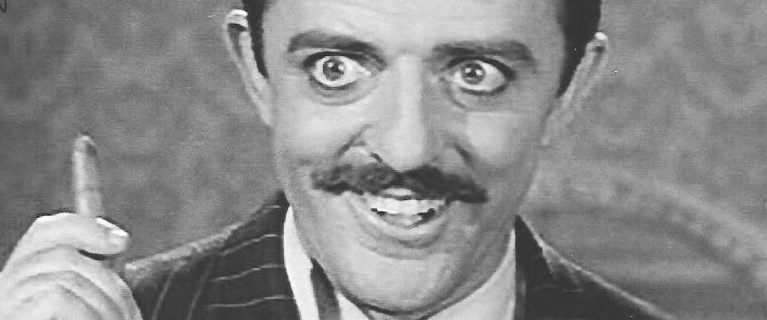
Andelman: Really? I want to mention some of the other people you’ve interviewed here. Speaking of “The Munsters,” of course you have Butch Patrick and Al Lewis. You have Pat Priest. Actually, you had multiple interviews with John Astin from “The Addams Family” that are kind of culled, and you put them together. You talk to Lisa Loring from “The Addams Family.” (John) Zacherle, who I remember very well from the UHF channels, the “Shock Theater” and such. You also talk to a lot of the magazine people, the publishers, Russ Jones, Jim Warren, who I’ve interviewed at great length, and Forry Ackerman. Who was the best “get” for you? Who were you most excited to get to talk to over the years?
Voger: It probably is Grandpa Munster (laughs). But, I mean, like I said, everybody made their contribution. If I hadn’t have gotten Forry Ackerman or Jim Warren, that would be a hole. If I didn’t talk to somebody — for instance, I didn’t talk to (Bill) Campbell, who did the Weird-Ohs art, so I quote from OldModelKits.com, identified as such. Forry Ackerman was great. “Uncle Forry.” He was there when we grew up. He provided so many wonderful childhood memories.
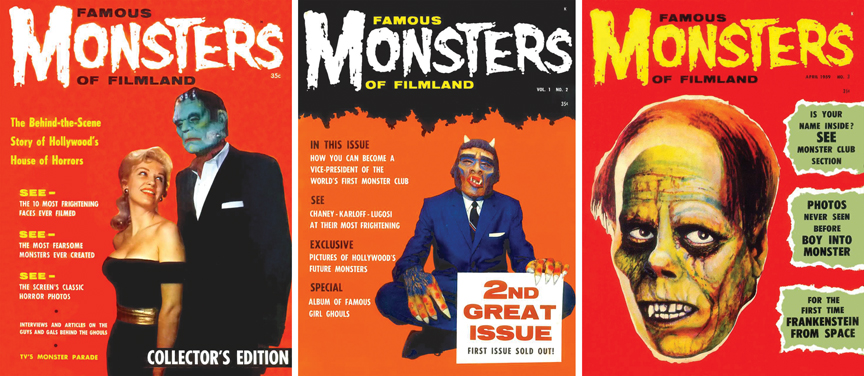
One of the things I learned from talking to Jim Warren — and Forry Ackerman — I always assumed that Jim Warren was the guy who sat in the office, and that Forry Ackerman put the book together. Both of them told me that really, Jim did the layout. Jim was the unnamed art director of Famous Monsters. He created that logo. He did its first painted cover with issue #3. He developed the two-leg, two-column, layout system. All that creepy headline type that they would do, that was specific to each story. And he was the guy who hired Basil Gogos or Maurice Whitman or Ron Cobb to do all those amazing covers. And Forry said, “No, I had nothing to do with picking the covers. I would write stories; I would revise stories.” So he was strictly an editor. The two of them were quite a combination.
Andelman: I was never a big fan of the magazine Famous Monsters of Filmland. But the covers — you had to look at the covers. They were always excellent. For people who maybe don’t know Famous Monsters of Filmland, but might know that Jim Warren also published Eerie and Creepy and Vampirella, and The Spirit magazine for a year or two or three. I don’t know how long that was. I guess I should. All right, so, a couple more things here before we let you go. Two words. I want your reaction to one of the monsters in your book that you have a short interview with: Bill Cosby.
Voger: Well, of course, there is horrible baggage now that just comes with the mention of his name. It makes me very sad. There’s so much evidence. A man is innocent until proven guilty — I mean, there’s so much testimony.
Andelman: It’s incredible irony, though, that you have Bill Cosby in this book about monsters at this moment in time, though, isn’t it?
Voger: Yeah. The timing was awful. And who knows? Like I said, I’m heartbroken. He was a hero. I don’t know if I can say he is a hero. I don’t want to try him here.
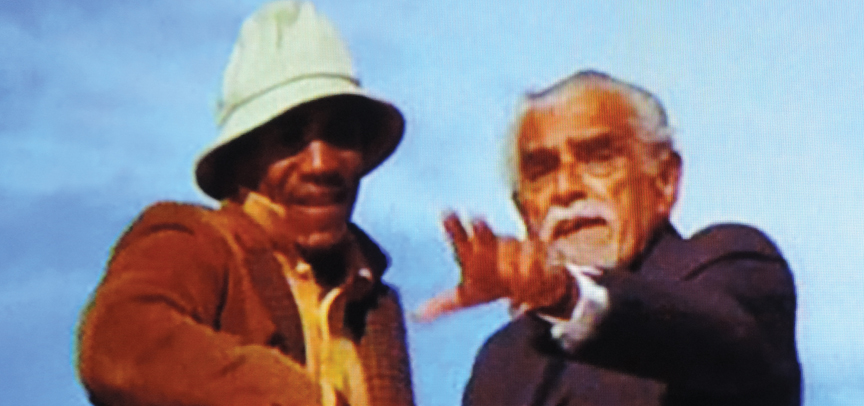
Andelman: Well, tell people why he’s in the book.
Voger: He’s in the book because I have a section on Boris Karloff, probably the greatest monster star. I would say even a greater monster star than Lon (Chaney) Sr. Because Lon Sr. wasn’t thinking “monster.” Karloff was actually playing monsters. Anyway, Karloff worked right up until the end. He was on “The Girl From U.N.C.L.E.,” he was on “I Spy.” So I have quotes from Bill Cosby remembering Karloff working with him on “I Spy.”
Andelman: It’s a great story, too. I mean, I’ve gotta give Cosby credit. He tells a great story about being in the back seat of the car. He’s in the back, and (Karloff is) in the front seat, and (Cosby is) still, as a grown man, still scared of Boris Karloff.
Voger: And if you ever see that episode, it was shot in Spain. … Karloff plays a man who thinks he’s Don Quixote. He is sword-fighting and he’s fighting and railing. He’s very energetic. And he looks very brittle. So he was that kind of guy. He just worked until the end. He wanted to die with his greasepaint on, and he did it.

Andelman: So two more words. I want you to explain to people why these words are in your book: Black Sabbath.
Voger: Well, it goes back to Boris Karloff again. Black Sabbath, of course, is a heavy metal band, or proto-metalists. They were really just a very heavy – like, Cream on downs – blues band from Birmingham, England. They named their band after a Boris Karloff film, Mario Bava’s 1964 Italian film, “Black Sabbath.” Ozzy Osbourne, the lead singer, told me that. So did Tony Iommi, the guitar player. So I have it from excellent authority that they named their band after a Boris Karloff movie.
Andelman: And how appropriate that years later, Ozzy becomes well known for biting the head off a bat. Perfect. Perfect symmetry, right?
Voger: Yeah. Karloff came close to biting the head off a bat in “Black Sabbath.” It was the only film in which he played a vampire. He never played a werewolf. He played the Mummy, Frankenstein, and even a vampire when he was in his late 70s, in “Black Sabbath.”
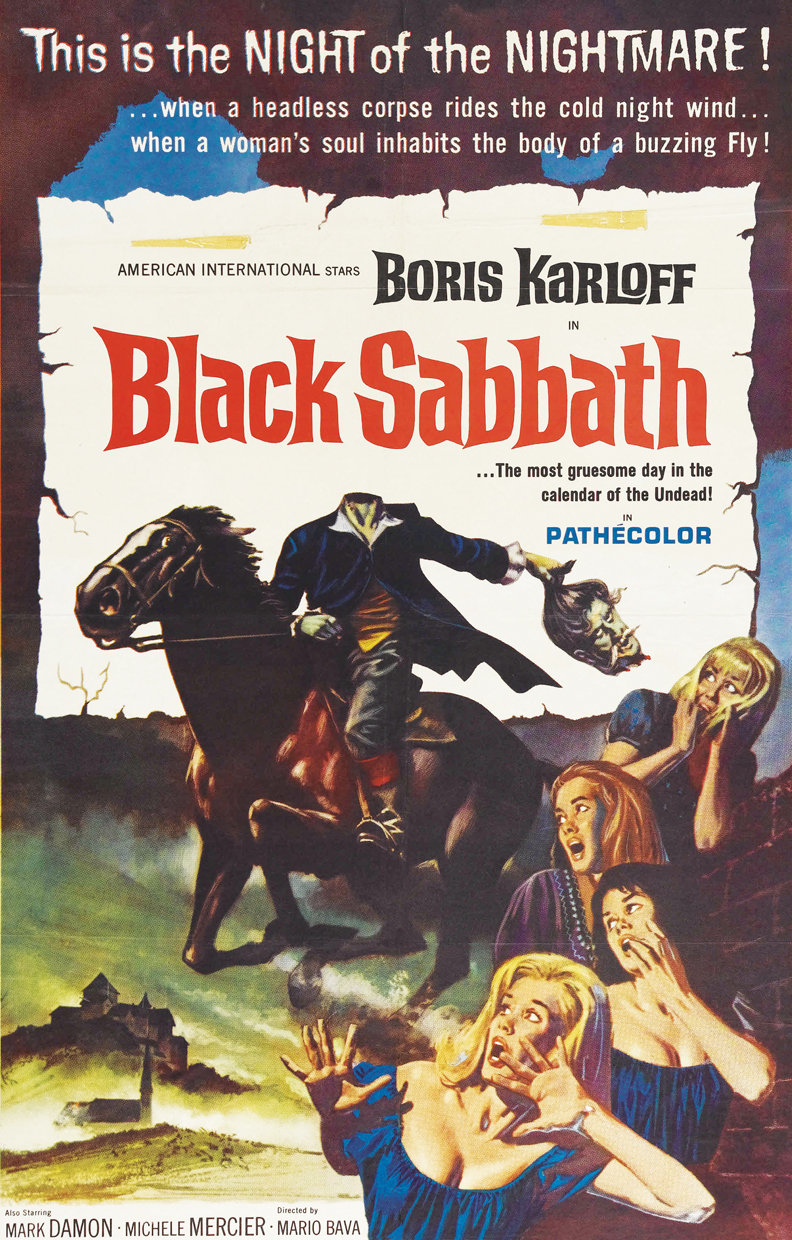 Andelman: Kind of a last thing here: For young people who were born after this period, are there maybe a handful of monster movies that they might have overlooked, that you would send them to check out, to kind of give them a sense of this period?
Andelman: Kind of a last thing here: For young people who were born after this period, are there maybe a handful of monster movies that they might have overlooked, that you would send them to check out, to kind of give them a sense of this period?
Voger: Of course, I would point to the Universal classics: “Frankenstein,” “Dracula,” “The Wolf Man.” “Frankenstein Meets the Wolf Man” is really cool. And the ones where they had all three monsters: “House of Frankenstein,” “House of Dracula.” My favorite movie of all time — counting “Citizen Kane,” counting “The Godfather” — is “Abbott and Costello Meet Frankenstein.” But I would also want to make sure that they saw the Ed Wood movies. I’d want to make sure they saw “Bride of the Monster” and “Plan 9 From Outer Space.” I’d want to make sure they saw the really cool, cheezy American International movies of the ’50s, like “Ghost of Dragstrip Hollow” and “Invasion of the Saucer Men.” I’d try to make it eclectic.
Andelman: Very good. So what’s next for you?
Voger: The next thing I’m going to do, Bob, is I’m going to go back out there into the newsroom, where they’re all cursing my name, and I’m going to slap the Food page together for the Trenton Times.
Andelman: Uh, okay. All right. So not another book project at the moment?

Voger: I have some pitches out, but, you know, I’m Irish and superstitious. But please visit MarkVoger.com. I’m always updating it and putting blogs (on it) and reviewing old movies. That’s where I’m trying to keep my writing thing going. So probably the next cool thing I gonna do is my next post for the website.
Andelman: Well, folks, listen, you can find Mark Voger’s brightly illustrated new book, “Monster Mash: The Creepy, Kooky Monster Craze in America 1957-1972” – he’s holding it up there …
Voger: Yeah, baby.
Andelman: … in great stores everywhere. Or you can order it right now at a great price at MrMedia.com. … So you mentioned MarkVoger.com is a website. Are you on social media? Twitter? Facebook? Things like that?
Voger: No, Bob, I’m not. I’m pretty behind-the-times. I’m gonna show you my phone. (Holds up phone) Here’s my phone. I’m not on the Facebook. But, I mean, one of these days.
Andelman: You’ll get around to it.
Voger: Yeah.
Andelman: Well, Mark Voger, fun book, fun conversation, and thank you so much for joining us on “Mr. Media” today.
Voger: Bob, thank you very much for having me. I very much appreciate it, and I had a blast.